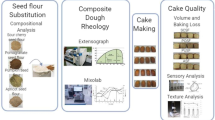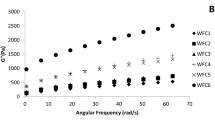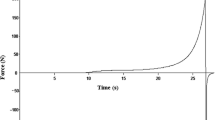Abstract
The aim of this study was to assess the potential of different seed flours for cake making and to determine the effect of substitution of wheat with the seed flours on dough rheology and shelf life of the cakes. Composite flours were produced by substituting wheat flour with graded levels (5%, 10%, and 15%) of apricot seed flour (ASF), sour cherry seed flour (CSF), pomegranate seed flour (POSF), and pumpkin seed flour (PUSF). Farinograph was used to determine the effect of seed flour substitution on techno-functional attributes of wheat flour. Cake batter samples were characterized in terms of pH, density, viscosity, and volume of cakes. The shelf life of cake samples was monitored using quality parameters such as moisture, water activity, hardness, and elasticity. Correlation between farinograph characteristics and cake properties were also analyzed. Farinograph characteristics showed that dough prepared with seed flours have higher stability with lower softening degrees. pH and density of batter were not significantly (p > 0.05) affected, while viscosity varied significantly (p < 0.05) due to the type and substitution level of seed flour. The cakes substituted with PUSF had the lowest volume while the other seed flours did not cause a statistically significant (p > 0.05) change. Throughout the storage period, water activity and moisture loss of cakes substituted with the seed flours did not differ significantly (p > 0.05) from the control (100% wheat cake). Texture analysis showed that softer cakes were produced with seed flour substitutions especially when CSF was used. The increase in firmness and elasticity loss was lower in substituted cakes compared to control. The results could have important implications for the valorization of seed flours to produce functional baked products with high protein content.




Similar content being viewed by others
References
I. Koca et al., The use of grape, pomegranate and rosehip seed flours in Turkish noodle (erişte) production. J. Food Process. Preserv. 42(1), e13343 (2018)
N. Dhen et al., Effect of apricot kernels flour on pasting properties, pastes rheology and gels texture of enriched wheat flour. Eur. Food Res. Technol. 243(3), 419–428 (2017)
M. Białek et al., Partial replacement of wheat flour with pumpkin seed flour in muffins offered to children. CyTA-Journal of Food 14(3), 391–398 (2016)
M. Çelik, M. Güzel, M. Yildirim, Effect of pH on protein extraction from sour cherry kernels and functional properties of resulting protein concentrate. J. Food Sci. Technol. 56(6), 3023–3032 (2019)
I. Bak et al., Isolation and analysis of bioactive constituents of sour cherry (Prunus cerasus) seed kernel: an emerging functional food. J. Med. Food 13(4), 905–910 (2010)
A. Czompa et al., Cardioprotection Afforded by Sour Cherry Seed Kernel: The Role of Heme Oxygenase-1. J. Cardiovasc. Pharmacol. 64(5), 412–419 (2014)
B. Juhasz et al., Cardioprotective effects of sour cherry seed extract (SCSE) on the hypercholesterolemic rabbit heart. Curr. Pharm. Design 19(39), 6896–6905 (2013)
P. Jing et al., Antioxidant properties and phytochemical composition of China-grown pomegranate seeds. Food Chem. 132(3), 1457–1464 (2012)
A. Femenia et al., Chemical composition of bitter and sweet apricot kernels. J. Agric. Food Chem. 43(2), 356–361 (1995)
E.Z. Gomaa, In vitro antioxidant, antimicrobial, and antitumor activities of bitter almond and sweet apricot (Prunus armeniaca L.) kernels. Food Sci. Biotechnol. 22(2), 455–463 (2013)
H.-K. Chang et al., Armeniacae semen extract suppresses lipopolysaccharide-induced expressions of cycloosygenase-2 and inducible nitric oxide synthase in mouse BV2 microglial cells. Biol. Pharmaceut. Bull. 28(3), 449–454 (2005)
Hh. Lee et al., Chemical composition and antimicrobial activity of the essential oil of apricot seed. Phytotherapy Res. 28(12), 1867–1872 (2014)
H.-K. Chang et al., Amygdalin induces apoptosis through regulation of Bax and Bcl-2 expressions in human DU145 and LNCaP prostate cancer cells. Biol. Pharmaceut. Bull. 29(8), 1597–1602 (2006)
A. Kolesárová et al., Effect of apricot seeds on renal structure of rabbits. Potravinárstvo: Slovak J. Food Sci. 11(1), 309–314 (2017)
K. Michalcová et al., Influence of apricot kernels on blood plasma levels of selected anterior pituitary hormones in male and female rabbits in vivo. Sci. P. Anim. Sci. Biotechnol. 49(1), 109–114 (2016)
Z. Zhu, N. Qiu, J. Yi, Production and characterization of angiotensin converting enzyme (ACE) inhibitory peptides from apricot (Prunus armeniaca L.) kernel protein hydrolysate. Eur. Food Res. Technol. 231(1), 13–19 (2010)
X.-E. Huang et al., Comparison of lifestyle risk factors by family history for gastric, breast, lung and colorectal cancer. Asian Pac. J. Cancer Prev. 5(4), 419–427 (2004)
G.O. Fruhwirth, A. Hermetter, Seeds and oil of the Styrian oil pumpkin: Components and biological activities. Eur. J. Lipid Sci. Technol. 109(11), 1128–1140 (2007)
J. Parry et al., Chemical Compositions, Antioxidant Capacities, and Antiproliferative Activities of Selected Fruit Seed Flours. J. Agric. Food Chem. 54(11), 3773–3778 (2006)
S.Y. Giami, S.C. Achinewhu, C. Ibaakee, The quality and sensory attributes of cookies supplemented with fluted pumpkin (Telfairia occidentalis Hook) seed flour. Int. J. Food Sci. Technol. 40(6), 613–620 (2005)
C.J. Freitas, D.R. Valente, S.P. Cruz, Physical, Chemical and Sensory Characteristics of Cookies Made of Pumpkin Seed Flour (PSF) and Baru Seed Flour (BSF) for Celiac Disease, vol. 9 (Food, Nutrition & Health, Demetra, 2014), pp. 1003–1019
M. Białek et al., Partial replacement of wheat flour with pumpkin seed flour in muffins offered to children. CyTA - J. Food 14(3), 391–398 (2016)
J.E.R. BATISTA et al., Partial replacement of wheat flour by pumpkin seed flour in the production of cupcakes filled with carob. Food Sci. Tech., 2018(AHEAD): p. 0–0
L. Dyshlyuk et al., In vivo study of medical and biological properties of functional bakery products with the addition of pumpkin flour. Bioactive Carbohydr. Diet. Fibre 12, 20–24 (2017)
CMd.S. Gorgônio, M. Pumar, C.G. Mothé, Macrocospic and physiochemical characterization of a sugarless and gluten-free cake enriched with fibers made from pumpkin seed (Cucurbita maxima, L.) flour and cornstarch. Food Sci. Technol. 31, 109–118 (2011)
L. Costa et al., Physicochemical and rheological characterization of pan bread made with pumpkin seed flour. International Food Research Journal 25(4), 1489–1496 (2018)
H. Bourekoua et al., Pomegranate seed powder as a functional component of gluten-free bread (Physical, sensorial and antioxidant evaluation). Int. J. Food Sci. Technol. 53(8), 1906–1913 (2018)
H. Gül, H. Şen, Effects of pomegranate seed flour on dough rheology and bread quality. CyTA - Journal of Food 15(4), 622–628 (2017)
Z. Saeidi, B. Nasehi, H. Jooyandeh, Optimization of gluten-free cake formulation enriched with pomegranate seed powder and transglutaminase enzyme. J. Food Sci. Technol. 55(8), 3110–3118 (2018)
Ö Özboy-Özbaş, I.T. Seker, I. Gökbulut, Effects of resistant starch, apricot kernel flour, and fiber-rich fruit powders on low-fat cookie quality. Food Sci. Biotechnol. 19(4), 979–986 (2010)
W. Horwitz, Moisture in nuts and nut products (AOAC Official Method 925.40). Officials methods of analysis of AOAC International, 17th edn. (AOAC International, Gaithersburg, MD, 2000)
A. International, Method 948.22, Lipid and oil, Ch. 40, p. 1; Method 950.49, Ash. Ch. 40, p. 2; Method 990.03, Crude protein, Ch. 4. Official Methods of Analysis of AOAC International, 2000: p. 26–27
H. William, Official methods of analysis of AOAC international. AOAC official method 985.29, 2000
A.o.O.A. Chemists, Microchemical determination of nitrogen, micro-kjeldahl method 960.52. 1990, AOAC International Washington, DC. p. 342–343
AOAC., Ash of flour. Method 923.03. 1997, Association of official Analytical Chemists International Washington, DC
W. Horwitz, Protein (crude) in nuts and nut products. Improved Kjeldahl method (AOAC Official Method 950.48). Officials Methods of Analysis of AOAC International, 17th edn. (AOAC International, Gaithersburg, MD, USA, 2000)
M.E. El-Demery, S. Elsanat, Influence of apricot kernel flour addition on aensory characteristics of spaghetti Egypt. J. Food Sci. 38, 49–65 (2010)
F.S. El-Safy, R.H. Salem, M. Abd El-Ghany, Chemical and nutritional evaluation of different seed flours as novel sources of protein. World J. Dairy & Food Sci. 7(1), 59–65 (2012)
E. Eyidemir, M. Hayta, The effect of apricot kernel flour incorporation on the physicochemical and sensory properties of noodle. African J. Biotechnol. 8(1), 85–90 (2009)
C.M.d.S. Gorgônio, M. Pumar, C.G. Mothé, Macrocospic and physiochemical characterization of a sugarless and gluten-free cake enriched with fibers made from pumpkin seed (Cucurbita maxima, L.) flour and cornstarch. Food Science and Technology 31(1), 109–118 (2011)
R. Navarro-Cortez et al., Development of extruded ready-to-eat snacks using pumpkin seed Cucurbita pepo and nixtamalized maize Zea mays flour blends. Revista Mexicana de Ingeniería Química. 15(2), 409–422 (2016)
I. Nikolić et al., Possibility of the production of functional low-fat food spread of Hull‐less pumpkin seed flour from rheological and textural aspect. J. Texture Stud. 45(4), 324–333 (2014)
G. Sharma, S. Lakhawat, Development, quality evaluation and acceptability of pumpkin seed flour incorporated in gravy. J. Nutr. Food Sci. (2017). https://doi.org/10.4172/2155-9600.1000613
A.-F. Ammar et al., Effect of the Addition of Alhydwan Seed Flour on the Dough Rheology, Bread Quality, Texture Profile and Microstructure of Wheat Bread. Journal of Texture Studies 47(6), 484–495 (2016)
D. Peressini, A. Sensidoni, Effect of soluble dietary fibre addition on rheological and breadmaking properties of wheat doughs. J. Cereal Sci. 49(2), 190–201 (2009)
S. Mercier et al., Mixing properties and gluten yield of dough enriched with pea protein isolates. J. Food Res. 1(1), 13 (2012)
N. Nikolić et al., The effect of some protein rich flours on farinograph properties of the wheat flour. Adv. Technol. 2(1), 20–25 (2013)
S. Hejri-Zarifi et al., Dough performance, quality and shelf life of flat bread supplemented with fractions of germinated date seed. J. Food Sci. Technol. 51(12), 3776–3784 (2014)
G. Gökşen, H. Ekiz, Effect of Prunus mahaleb seed powder on dough rheology and bread quality. J. Food Qual. 39(5), 436–444 (2016)
H. Gül, H. Şen, Effects of pomegranate seed flour on dough rheology and bread quality. CyTA-Journal of Food 15(4), 622–628 (2017)
M. ABU-GHOUSH et al., Dietary Fibers Effect from Mango Peels and Date Seeds on Rheological properties of Arabic Bread Quality: A Novel approach on applying Fuzzy Modeling in Studying Rolling/Folding and Tearing values. European Academic Research 4(11), 9947–9969 (2017)
M. Murat Karaoğlu, Cephalaria syriaca addition to wheat flour dough and effect on rheological properties. Int. J. Food Sci. Technol. 41, 37–46 (2006)
J.H. Kim et al., Physical and sensory characteristics of fibre-enriched sponge cakes made with Opuntia humifusa. LWT 47(2), 478–484 (2012)
M.A. Gularte, M. Gómez, C.M. Rosell, Impact of legume flours on quality and in vitro digestibility of starch and protein from gluten-free cakes. Food Bioprocess Technol. 5(8), 3142–3150 (2012)
D.J. Ash, J.C. Colmey, Role of pH in cake baking. Bakers digest, 1973
M. Singh, J.A. Byars, S.X. Liu, Navy Bean Flour Particle Size and Protein Content Affect Cake Baking and Batter Quality1. J. Food Sci. 80(6), E1229–E1234 (2015)
P. Itthivadhanapong, A. Sangnark, Effects of substitution of black glutinous rice flour for wheat flour on batter and cake properties. International Food Research Journal 23(3), 1190 (2016)
J. Rajiv et al., Rheology, fatty acid profile and storage characteristics of cookies as influenced by flax seed (Linum usitatissimum). J. Food Sci. Technol. 49(5), 587–593 (2012)
S.M. Fiszman, T. Sanz, A. Salvador, 13 - Instrumental Assessment of the Sensory Quality of Baked Goods, ed. by D. Kilcast. Instrumental Assessment of Food Sensory Quality (Woodhead Publishing, 2013), pp. 374–402
R. Krishnaiya, C. Kasar, S. Gupta, Influence of water chestnut (Trapa natans) on chemical, rheological, sensory and nutritional characteristics of muffins. Journal of Food Measurement and Characterization 10(2), 210–219 (2016)
D.M. Lebesi, C. Tzia, Use of endoxylanase treated cereal brans for development of dietary fiber enriched cakes. Innovative Food Science & Emerging Technologies 13, 207–214 (2012)
S. Grasso, S. Liu, L. Methven, Quality of muffins enriched with upcycled defatted sunflower seed flour. LWT 119, 108893 (2020)
S. Indriani et al., Quality characteristics of protein-enriched brown rice flour and cake affected by Bombay locust (Patanga succincta L.) powder fortification. LWT 119, 108876 (2020)
N. Sozer, Rheological properties of rice pasta dough supplemented with proteins and gums. Food Hydrocolloids 23(3), 849–855 (2009)
Acknowledgements
We thank Polen Food Inc. for their technical and financial support.
Author information
Authors and Affiliations
Corresponding author
Additional information
Publisher’s Note
Springer Nature remains neutral with regard to jurisdictional claims in published maps and institutional affiliations.
Rights and permissions
About this article
Cite this article
Aĝirbaş, H.E.T., Yavuz-Düzgün, M. & Özçelik, B. The effect of fruit seed flours on Farinograph characteristics of composite dough and shelf life of cake products. Food Measure 15, 3973–3984 (2021). https://doi.org/10.1007/s11694-021-00961-3
Received:
Accepted:
Published:
Issue Date:
DOI: https://doi.org/10.1007/s11694-021-00961-3




